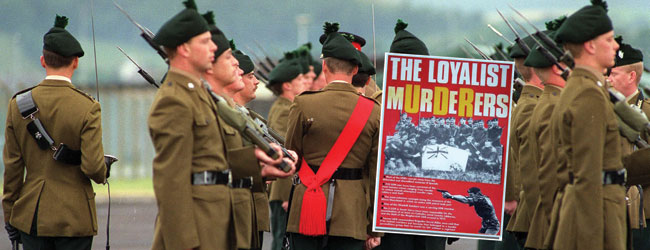18 August 2011
The UDR — not Dad’s Army but a sectarian militia
THE BRITISH ARMY’S ULSTER DEFENCE REGIMENT | NEW EVIDENCE SHOWS WHITEHALL KNEW OF REGIMENT’S LINKS WITH DEATH SQUADS
BY PEADAR WHELAN
» BY PEADAR WHELAN
BRITISH GOVERNMENT papers dating from 30 years ago prove what nationalists knew all along — that the British Army’s Ulster Defence Regiment was heavily involved in collusion with loyalist killer gangs.
Evidence uncovered by the Pat Finucane Centre shows that British military commanders knew of the links between what was then the largest regiment in the British Army, over which they had control, but ignored the information.
Roy Mason, the British Secretary of State in the late 1970s, also viewed the papers. Seemingly, he conveniently ignored their content as well.
The papers uncovered by the Pat Finucane Centre reveal that a British Army investigation into collusion was suspended after senior UDR officers claimed it would damage the morale of their soldiers!
Under scrutiny at the time was one unit from the Shankill Road in Belfast which contained Eddie McIlwaine, a member of the infamous ‘Shankill Butchers’ gang and the outlawed Ulster Volunteer Force.
The UVF was also given free access to UDR social clubs located in military bases. One UDR unit was believed to be behind a £47,000 fraud that benefited the loyalist murder gang.
Marked for “UK Eyes Only”, the papers show that one investigation into the activities of the UDR based in Girdwood Barracks found that its members were supplying both weapons and money to the UVF.
“The general impression gained is that ‘D’ and ‘G’ [companies] are the supply and financial support elements for local paramilitary organisations,” state the papers dated from 1977.
These UDR companies were also suspected of being involved in sectarian shootings, including the killings of two Catholics.
“There have been 16 reported cases of misuse, including negligent discharge . . . These involve ‘cowboy’ shooting with the inference of intimidation of Roman Catholics.”
The papers go on to say:
“As a result of a current, but minor, investigation, it was revealed that certain SNCOs [senior non-commissioned officers — sergeant and staff sergeant rank] had been involved or were involved in paramilitary activities.
“A review was carried out of security investigation/incidents involving the unit during the past six months and this, coupled with additional source information, produced a list of about 70 members of the unit with paramilitary traces. This figure had since grown.”
Despite this unfolding picture of UDR and loyalist links, British Ministry of Defence chiefs suppressed the reports.
Minutes of a meeting at British Army headquarters at Lisburn in 1978 stated:
“It would be desirable to avoid mention of the security investigation into UDR soldiers’ possible involvement with paramilitary organisations.”
The papers uncovered also disclose the full-time battalions of the UDR were formed after a meeting at Stormont with British Secretary of State Merlyn Rees and the loyalist Ulster Workers’ Council (UWC).
Also listed, in the minutes of those attending the meeting were representatives from the UDA, UVF, Red Hand Commando and Down Orange Welfare.
Paul O’Connor of the Pat Finucane Centre said the documents expose the “cosy relationship” between the British Government and loyalists.
“The Ministry of Defence said that it was a good idea and they went ahead. When the minister asked where the idea had come from, they were totally open about it.”
When these investigations were being carried out in the mid to late 1970s, the British Government was implementing its new political strategy in dealing with the conflict in the North.
As one strand of this new policy, ‘Ulsterisation’ meant withdrawing the British Army to a back-up role supporting the newly-trained and armed Royal Ulster Constabulary.
The UDR was also earmarked to play a more frontline role in combating the IRA.
It was therefore obvious that senior British military and political figures would choose to ignore the underground activities of the UDR.
In the late 1980s, the UDR had replaced the British Army in about 80% of the North and was stopping up to four million cars a year at checkpoints.
The 1989 killing of Loughlin Maginn proved to be a watershed in the story of the UDR’s crossover role between the British military and loyalist killers.
Maginn was targeted on the basis of classified UDR intelligence documents passed to the killers.
Two UDR members were charged with the Maginn killing which had been claimed by the UDA.
A UDR man was also charged and convicted of involvement in the murder of Jack Kielty, father of TV comedian Patrick Kielty, also in County Down.
Sinn Féin President Gerry Adams, quoted in September 1989, accused the Dublin Government of not taking collusion seriously. He said:
“Involvement by members of the British crown forces in the killings of Catholics is a matter of historical fact and well documented.”
We now know that the British Government and senior British military commanders were sitting on the evidence but allowed their UDR killing machine to carry on killing.
Follow us on Facebook
An Phoblacht on Twitter
Uncomfortable Conversations

An initiative for dialogue
for reconciliation
— — — — — — —
Contributions from key figures in the churches, academia and wider civic society as well as senior republican figures





